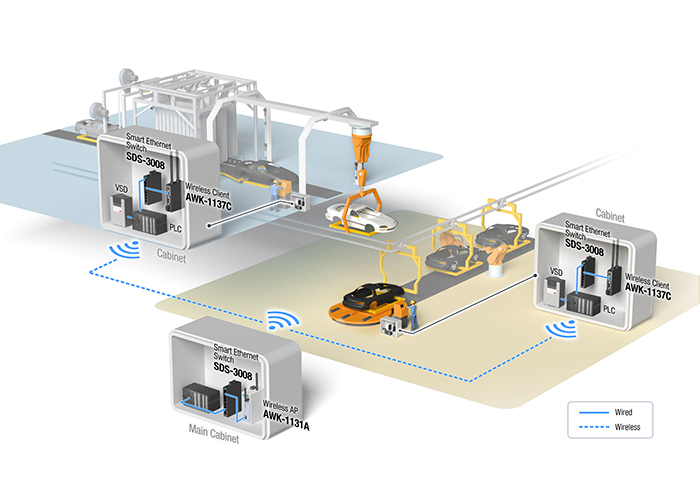An acclaimed automotive manufacturing facility in South Africa needed an overhead transfer system (OTS) to assist moving vehicles through the production process. The OTS transports the vehicle from the paint shop to the location where the vehicle is assembled. In order to perform this process, the operator uses a grab to send the car to the assembly section, where a second operator takes control of the grab and lowers the vehicle onto the conveyor belt. For this transfer to take place smoothly, there can be no delays after commands are sent by the operator.
Although this process may seem relatively straightforward, a reliable network architecture is required to ensure the process goes smoothly. Each of the cabinets located throughout the site contain variable-speed drives (VSDs), which are used to control the speed of the motors that operate the arms as well as the grab’s lifting mechanism. The most important part of the process requires the operator to use a PLC that has the industrial network protocol EtherNet/IP in order to operate the grab.
At the manufacturing site, the equipment installed inside the cabinets communicate with each other using wired communications, but the communication between cabinets takes place over Wi-Fi to save cabling costs. The wireless communication allows operators to know where the cab (the frame of the vehicle before assembly) is and avoid any problems from occurring, such as collisions. Hence, the main control cabinet needs to have a reliable, powerful Wi-Fi connection to ensure it can control and monitor the cabs as they move throughout the manufacturing facility.
To ensure the grab operates reliably, three important system requirements have to be fulfilled.

1. A Reliable Network Ensures That the Vehicle Is Transferred Efficiently
On industrial sites, it is imperative that data transmission between the operator and the grab is reliable, so that the manufacturing plant remains efficient and safe. Furthermore, it is essential that the wireless connection does not experience downtime as it plays a very important role in avoiding collisions on the production line and therefore avoids damage to property or personnel.
One of the main reasons why the communication between the operator and the machines was so efficient for this project was because Moxa’s SDS-3008 smart switch had tailor-made traffic management functions that met the operator’s requirements. EtherNet/IP-based PLCs often encounter broadcast problems when deployed at large manufacturing sites, but because our SDS-3008 can manage the flow of traffic, this problem was averted. Traffic management features are not available in unmanaged switches and although managed switches do have this functionality, it requires the operator to have IT expertise to perform the configurations. Another one of the main advantages of Moxa’s SDS-3008 is that it is designed for OT engineers who prefer to use plug-and-play devices, which help OT engineers who use managed switches often to avoid performing time-consuming configurations. Furthermore, in order to ensure smooth, powerful, and effective communications across Wi-Fi networks, Moxa’s AWK-1131A wireless AP and AWK-1137C client were used because they have industrial, rugged designs, which allow them to avoid interference that often occurs at manufacturing sites.
2. Industrial Design and Easy-To-Use Network Functions Simplify Maintenance
To improve operational efficiency within the automation industry, the operators can monitor the system status directly on the HMI or the SCADA system. Moxa’s SDS-3008 has the three most commonly used IA protocols embedded in the device, including EIP, which allows the operator to view the network from the HMI. This allows the operator to use a system that they are familiar with and it helps them to react in real time to any events that occur on the network and therefore minimize any system downtime that occurs.
3. Compact Size and Flexible Mounting Options for Installation in Confined Spaces
Limited space inside industrial cabinets often poses challenges for automation engineers and system integrators at manufacturing sites. Moxa’s SDS-3008 and AWK-1137C both have a palm-sized form factor and they support different installation options that allows them to fit into almost any industrial cabinet. By using Moxa’s devices, automation engineers and system integrators can use a solution that does not require a workaround and also speeds up deployment times.
Moxa's Solutions
Our wired and wireless networking solutions are the perfect fit for manufacturing environments. For more information, please download the application notes below:
SDS-3008 smart switch application note:
https://www.moxa.com/support/request_catalog_detail.aspx?id=3539
AWK-1137C wireless client application note:
https://www.moxa.com/support/request_catalog_detail.aspx?id=3589